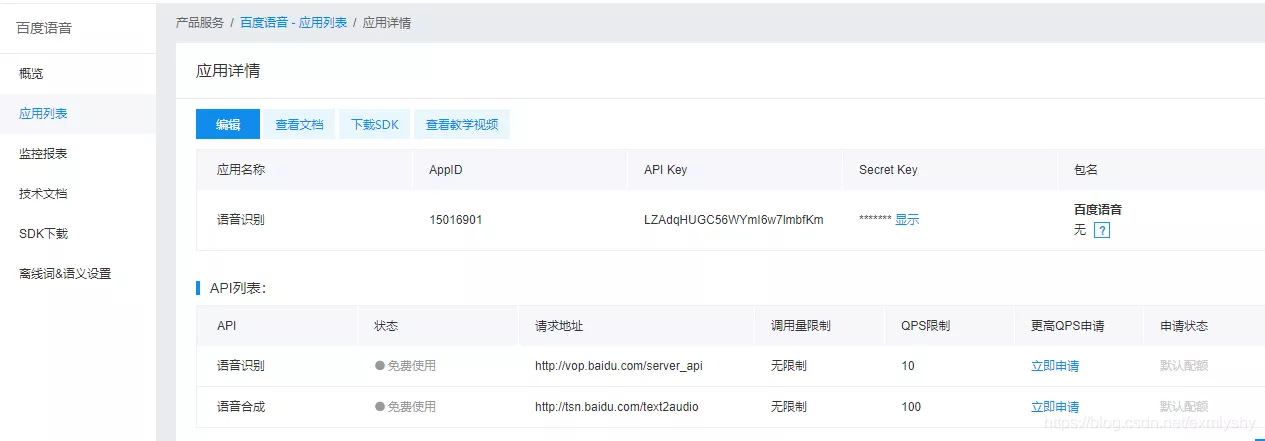Python调用百度api实现语音识别详解
最近在学习python,做一些python练习题
github上几年前的练习题
有一题是这样的:
使用 Python 实现:对着电脑吼一声,自动打开浏览器中的默认网站。
例如,对着笔记本电脑吼一声“百度”,浏览器自动打开百度首页。
然后开始search相应的功能需要的模块(windows10),理一下思路:
本地录音
上传录音,获得返回结果
组一个map,根据结果打开相应的网页
所需模块:
PyAudio:录音接口
wave:打开录音文件并设置音频参数
requests:GET/POST
为什么要用百度语音识别api呢?因为免费试用。。

不多说,登录百度云,创建应用

查看文档REST API文档
文档写的蛮详细的,简单概括就是
1.可以下载使用SDK

2.不需要下载使用SDK
选择2.
根据文档组装url获取token
处理本地音频以JSON格式POST到百度语音识别服务器,获得返回结果
语音格式
格式支持:pcm(不压缩)、wav(不压缩,pcm编码)、amr(压缩格式)。推荐pcm 采样率 :16000 固定值。 编码:16bit 位深的单声道。
百度服务端会将非pcm格式,转为pcm格式,因此使用wav、amr会有额外的转换耗时。
保存为pcm格式可以识别,只是windows自带播放器识别不了pcm格式的,所以改用wav格式,毕竟用的模块是wave?
首先是本地录音
import wave
from pyaudio import PyAudio, paInt16
framerate = 16000 # 采样率
num_samples = 2000 # 采样点
channels = 1 # 声道
sampwidth = 2 # 采样宽度2bytes
FILEPATH = 'speech.wav'
def save_wave_file(filepath, data):
wf = wave.open(filepath, 'wb')
wf.setnchannels(channels)
wf.setsampwidth(sampwidth)
wf.setframerate(framerate)
wf.writeframes(b''.join(data))
wf.close()
#录音
def my_record():
pa = PyAudio()
#打开一个新的音频stream
stream = pa.open(format=paInt16, channels=channels,
rate=framerate, input=True, frames_per_buffer=num_samples)
my_buf = [] #存放录音数据
t = time.time()
print('正在录音...')
while time.time() < t + 4: # 设置录音时间(秒)
#循环read,每次read 2000frames
string_audio_data = stream.read(num_samples)
my_buf.append(string_audio_data)
print('录音结束.')
save_wave_file(FILEPATH, my_buf)
stream.close()
然后是获取token
import requests
import base64 #百度语音要求对本地语音二进制数据进行base64编码
#组装url获取token,详见文档
base_url = "https://openapi.baidu.com/oauth/2.0/token?grant_type=client_credentials&client_id=%s&client_secret=%s"
APIKey = "LZAdqHUGC********mbfKm"
SecretKey = "WYPPwgHu********BU6GM*****"
HOST = base_url % (APIKey, SecretKey)
def getToken(host):
res = requests.post(host)
return res.json()['access_token']
#传入语音二进制数据,token
#dev_pid为百度语音识别提供的几种语言选择
def speech2text(speech_data, token, dev_pid=1537):
FORMAT = 'wav'
RATE = '16000'
CHANNEL = 1
CUID = '********'
SPEECH = base64.b64encode(speech_data).decode('utf-8')
data = {
'format': FORMAT,
'rate': RATE,
'channel': CHANNEL,
'cuid': CUID,
'len': len(speech_data),
'speech': SPEECH,
'token': token,
'dev_pid':dev_pid
}
url = 'https://vop.baidu.com/server_api'
headers = {'Content-Type': 'application/json'}
# r=requests.post(url,data=json.dumps(data),headers=headers)
print('正在识别...')
r = requests.post(url, json=data, headers=headers)
Result = r.json()
if 'result' in Result:
return Result['result'][0]
else:
return Result
最后就是对返回的结果进行匹配,这里使用webbrowser这个模块
webbrower.open(url)
完整demo
#!/usr/bin/env python
# -*- coding: utf-8 -*-
# Date : 2018-12-02 19:04:55
import wave
import requests
import time
import base64
from pyaudio import PyAudio, paInt16
import webbrowser
framerate = 16000 # 采样率
num_samples = 2000 # 采样点
channels = 1 # 声道
sampwidth = 2 # 采样宽度2bytes
FILEPATH = 'speech.wav'
base_url = "https://openapi.baidu.com/oauth/2.0/token?grant_type=client_credentials&client_id=%s&client_secret=%s"
APIKey = "********"
SecretKey = "************"
HOST = base_url % (APIKey, SecretKey)
def getToken(host):
res = requests.post(host)
return res.json()['access_token']
def save_wave_file(filepath, data):
wf = wave.open(filepath, 'wb')
wf.setnchannels(channels)
wf.setsampwidth(sampwidth)
wf.setframerate(framerate)
wf.writeframes(b''.join(data))
wf.close()
def my_record():
pa = PyAudio()
stream = pa.open(format=paInt16, channels=channels,
rate=framerate, input=True, frames_per_buffer=num_samples)
my_buf = []
# count = 0
t = time.time()
print('正在录音...')
while time.time() < t + 4: # 秒
string_audio_data = stream.read(num_samples)
my_buf.append(string_audio_data)
print('录音结束.')
save_wave_file(FILEPATH, my_buf)
stream.close()
def get_audio(file):
with open(file, 'rb') as f:
data = f.read()
return data
def speech2text(speech_data, token, dev_pid=1537):
FORMAT = 'wav'
RATE = '16000'
CHANNEL = 1
CUID = '*******'
SPEECH = base64.b64encode(speech_data).decode('utf-8')
data = {
'format': FORMAT,
'rate': RATE,
'channel': CHANNEL,
'cuid': CUID,
'len': len(speech_data),
'speech': SPEECH,
'token': token,
'dev_pid':dev_pid
}
url = 'https://vop.baidu.com/server_api'
headers = {'Content-Type': 'application/json'}
# r=requests.post(url,data=json.dumps(data),headers=headers)
print('正在识别...')
r = requests.post(url, json=data, headers=headers)
Result = r.json()
if 'result' in Result:
return Result['result'][0]
else:
return Result
def openbrowser(text):
maps = {
'百度': ['百度', 'baidu'],
'腾讯': ['腾讯', 'tengxun'],
'网易': ['网易', 'wangyi']
}
if text in maps['百度']:
webbrowser.open_new_tab('https://www.baidu.com')
elif text in maps['腾讯']:
webbrowser.open_new_tab('https://www.qq.com')
elif text in maps['网易']:
webbrowser.open_new_tab('https://www.163.com/')
else:
webbrowser.open_new_tab('https://www.baidu.com/s?wd=%s' % text)
if __name__ == '__main__':
flag = 'y'
while flag.lower() == 'y':
print('请输入数字选择语言:')
devpid = input('1536:普通话(简单英文),1537:普通话(有标点),1737:英语,1637:粤语,1837:四川话\n')
my_record()
TOKEN = getToken(HOST)
speech = get_audio(FILEPATH)
result = speech2text(speech, TOKEN, int(devpid))
print(result)
if type(result) == str:
openbrowser(result.strip(','))
flag = input('Continue?(y/n):')
经测试,大吼效果更佳
到此这篇关于Python调用百度api实现语音识别详解的文章就介绍到这了,更多相关Python 语音识别内容请搜索软件开发网以前的文章或继续浏览下面的相关文章希望大家以后多多支持软件开发网!